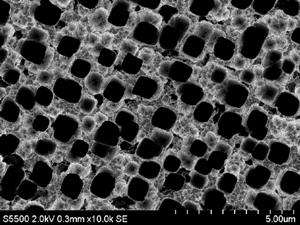Oct 14 2010
A team of Rice University and Lockheed Martin scientists has discovered a way to use simple silicon to radically increase the capacity of lithium-ion batteries.
Sibani Lisa Biswal, an assistant professor of chemical and biomolecular engineering, revealed how she, colleague Michael Wong, a professor of chemical and biomolecular engineering and of chemistry, and Steven Sinsabaugh, a Lockheed Martin Fellow, are enhancing the inherent ability of silicon to absorb lithium ions.
Their work was introduced today at Rice's Buckyball Discovery Conference, part of a yearlong celebration of the 25th anniversary of the Nobel Prize-winning discovery of the buckminsterfullerene, or carbon 60, molecule. It could become a key component for electric car batteries and large-capacity energy storage, they said.
 Microscopic pores dot a silicon wafer prepared for use in a lithium-ion battery. Silicon has great potential to increase the storage capacity of batteries, and the pores help it expand and contract as lithium is stored and released.
Microscopic pores dot a silicon wafer prepared for use in a lithium-ion battery. Silicon has great potential to increase the storage capacity of batteries, and the pores help it expand and contract as lithium is stored and released.
"The anode, or negative, side of today's batteries is made of graphite, which works. It's everywhere," Wong said. "But it's maxed out. You can't stuff any more lithium into graphite than we already have."
Silicon has the highest theoretical capacity of any material for storing lithium, but there's a serious drawback to its use. "It can sop up a lot of lithium, about 10 times more than carbon, which seems fantastic," Wong said. "But after a couple of cycles of swelling and shrinking, it's going to crack."
Other labs have tried to solve the problem with carpets of silicon nanowires that absorb lithium like a mop soaks up water, but the Rice team took a different tack.
With Mahduri Thakur, a post-doctoral researcher in Rice's Chemical and Biomolecular Engineering Department, and Mark Isaacson of Lockheed Martin, Biswal, Wong and Sinsabaugh found that putting micron-sized pores into the surface of a silicon wafer gives the material sufficient room to expand. While common lithium-ion batteries hold about 300 milliamp hours per gram of carbon-based anode material, they determined the treated silicon could theoretically store more than 10 times that amount.
Sinsabaugh described the breakthrough as one of the first fruits of the Lockheed Martin Advanced Nanotechnology Center of Excellence at Rice (LANCER). He said the project began three years ago when he met Biswal at Rice and compared notes. "She was working on porous silicon, and I knew silicon nanostructures were being looked at for battery anodes. We put two and two together," he said.
Nanopores are simpler to create than silicon nanowires, Biswal said. The pores, a micron wide and from 10 to 50 microns long, form when positive and negative charge is applied to the sides of a silicon wafer, which is then bathed in a hydrofluoric solvent. "The hydrogen and fluoride atoms separate," she said. "The fluorine attacks one side of the silicon, forming the pores. They form vertically because of the positive and negative bias."
The treated silicon, she said, "looks like Swiss cheese."
The straightforward process makes it highly adaptable for manufacturing, she said. "We don't require some of the difficult processing steps they do -- the high vacuums and having to wash the nanotubes. Bulk etching is much simpler to process.
"The other advantage is that we've seen fairly long lifetimes. Our current batteries have 200-250 cycles, much longer than nanowire batteries," said Biswal.
They said putting pores in silicon requires a real balancing act, as the more space is dedicated to the holes, the less material is available to store lithium. And if the silicon expands to the point where the pore walls touch, the material could degrade.
The researchers are confident that cheap, plentiful silicon combined with ease of manufacture could help push their idea into the mainstream.
"We are very excited about the potential of this work," Sinsabaugh said. "This material has the potential to significantly increase the performance of lithium-ion batteries, which are used in a wide range of commercial, military and aerospace applications.
Biswal and Wong plan to study the mechanism by which silicon absorbs lithium and how and why it breaks down. "Our goal is to develop a model of the strain that silicon undergoes in cycling lithium," Wong said. "Once we understand that, we'll have a much better idea of how to maximize its potential."
Source: http://media.rice.edu/